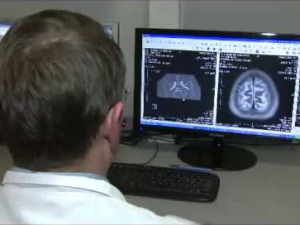Multiple sclerosis
 Multiple sclerosis refers to diseases of the nervous system. The disease develops at a young age( 15 years) and in middle age( 40 years).The peculiarity of this disease is the simultaneous defeat of several different parts of the nervous system, which leads to the development of neurological symptoms. The remitting course, that is, the periods of deterioration( exacerbation) and improvement( remission) alternate - this is another feature of multiple sclerosis. More details about this disease we will tell in today's article "Diagnosis and treatment of multiple sclerosis."
Multiple sclerosis refers to diseases of the nervous system. The disease develops at a young age( 15 years) and in middle age( 40 years).The peculiarity of this disease is the simultaneous defeat of several different parts of the nervous system, which leads to the development of neurological symptoms. The remitting course, that is, the periods of deterioration( exacerbation) and improvement( remission) alternate - this is another feature of multiple sclerosis. More details about this disease we will tell in today's article "Diagnosis and treatment of multiple sclerosis."
The basis of the disease - the emergence of foci of complete destruction of the nerve shell in the spinal cord and the brain( the nerve shell - myelin).Foci of destruction were called "plaques of multiple sclerosis."As a rule, plaques are of a small size, but with the progression of multiple sclerosis, larger drain plaques can form.
Causes of Multiple Sclerosis
 To date, the cause of the development of this disease remains a mystery. Nevertheless, there is a generally accepted view that the cause of the development of multiple sclerosis is a random combination of unfavorable internal and external factors in a person.
To date, the cause of the development of this disease remains a mystery. Nevertheless, there is a generally accepted view that the cause of the development of multiple sclerosis is a random combination of unfavorable internal and external factors in a person.
Adverse external factors:
- frequent bacterial and viral infections;
- power features;
- frequent stressful situations;
- is a geoecological place of residence, which affects the child's organism in particular;
- radiation and the effect of toxic substances;
- injury.
Genetic predisposition to this disease is associated with the combination of several genes, which cause disturbances in the immunoregulation system. Each person has a regulation of the immune response, in which several genes participate simultaneously. In such cases, the number of interacting genes is large.
Studies conducted in recent years have confirmed that the immune system participates( primary or secondary) in the development of this disease.
Failures in the immune system can be related to the characteristics of a set of specific genes that control the immune response.
The autoimmune theory of the development of multiple sclerosis( finding "alien" nerve cells of immunity and their destruction) has become most widespread.
The basis for the treatment of multiple sclerosis is the correction of immune disorders, this is due to the fact that immunological disorders have taken the lead.
With the development of multiple sclerosis, NTU-1 virus is considered to be a causative agent of the disease.
It is believed that a group of viruses or one virus in the patient's body can cause serious malfunctions of immune regulation, which can be accompanied by destruction of the myelin structures of the nervous system and inflammatory processes.
Diagnosis of multiple sclerosis
 Diagnosis of the disease is based on the patient's interrogation data obtained during a neurological examination and on additional examinations.
Diagnosis of the disease is based on the patient's interrogation data obtained during a neurological examination and on additional examinations.
At present, the most informative method of examination is magnetic resonance imaging of the spinal cord and brain, as well as the presence of oligoclonal immunoglobulins in the cerebrospinal fluid.
Immunological reaction is given a leading role and in view of this fact, immunological monitoring( immunological blood test) should be regularly examined.
Immunological monitoring will allow a doctor to compare new immunity indications with old indicators, and, based on these data, make the right decisions for further treatment.
Treatment of multiple sclerosis
 The main treatment is:
The main treatment is:
- treatment of exacerbations;
- slowing the progression of the disease and disability of the patient;
- prevention of complications( possible complications - pressure sores, contractures);
- improving the quality of life;
- decreased severity of various neurologic symptoms.
Glucocorticosteroids are the main drugs used in the treatment of exacerbations. Drugs are prescribed to all patients suffering from this disease when relieving exacerbation, both moderate severity and severe. If the disease occurs with exacerbations of mild degree, then glucocorticosteroids are prescribed only in the presence of symptoms of damage to the brainstem and in optic neuritis.
The most effective drug in this group is methylprednisolone( used intravenously).Dexamethasone is used parenterally, prednisolone is taken internally.
For multiple sclerosis, patients who receive glucocorticosteroids should strictly follow the diet.
In such cases it is necessary:
- to reduce the calorie content of food( best of all due to carbohydrates);
- increase potassium intake;
- to reduce sodium intake;
- try to avoid foods that irritate the gastrointestinal tract.
Cytotoxic drugs are prescribed if the disease progresses rapidly and / or there is no effectiveness from the use of immunomodulatory and glucocorticosteroid therapy, the purpose of which was to reduce the severity and frequency of exacerbations and slow the progression of the disease. The most effective drug is Mitoxantrone( Novantron).
Immunoglobulin is recommended to reduce the frequency of exacerbations and their severity, to prevent the progression of disability of the patient.
This medication is prescribed:
- in pediatric patients;
- for pregnant and lactating women;
- to people who do not tolerate glatiramer and interferon-beta acetate.
Patients aged 18-50 years with multiple sclerosis with or without mild or moderate disability, or who have had more than 2 exacerbations over the past two years, should receive interferon beta or glatiramer acetate. This will reduce the frequency and severity of exacerbations, slow the rate of progression of the disease.



